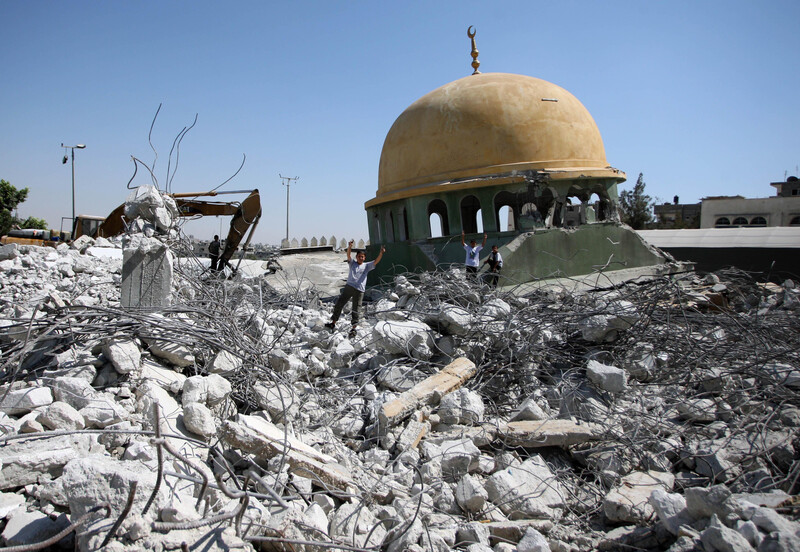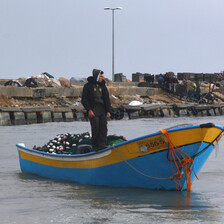The Electronic Intifada Gaza City 8 July 2011

Boys play in the rubble of al-Taqwa mosque in Gaza City, July 2009.
Maan ImagesGAZA CITY (IPS) - “The mosque was just 100 meters from our house,” said Mohammed, a resident of Beit Hanoun in the northern Gaza Strip. “We prayed there every day, five times a day. But it was more than a house of prayer.”
Mohammad was speaking about one of the 34 mosques completely destroyed during Operation Cast Lead, the 23-day Israeli attack on Gaza in 2008-2009.
The Israeli bombing on 4 January 2009, which flattened the Omar Ibn Abdul Aziz mosque in Beit Hanoun, also damaged numerous surrounding homes and the local sports club. “The blast sent rubble to our house,” Mohammed recalled. “Now we have go to one 15 minutes away, one we don’t know intimately.”
According to Hassan Saifi, a representative of the ministry for religious affairs in Gaza, a quarter of the Strip’s 800 mosques were damaged or destroyed in the Israeli attack on Gaza.
“Two hundred damaged mosques is a shocking amount,” Saifi said. “Among those, 34 throughout the Gaza Strip were completely destroyed.
“Especially in Gaza’s north, which was hit the hardest, completely destroying 15 mosques, the bombing of mosques inflicted many civilian casualties,” Saifi added, noting that the northern part of Gaza had a higher proportion of Palestinian refugees living in densely-inhabited camps.
“Mosque walls are frequently also the walls of the many homes packed around it. So when mosques are bombed, many homes are bombed at the same time.”
Girls killed in their sleep
With many mosques destroyed and over 150 more badly damaged by Israeli bombings, many in Gaza believed the destruction was intentional.
“The Israelis used state-of-the-art warplanes and unmanned drones with precision visual equipment,” Saifi said. “They destroyed many of our mosques during the very first days of their attacks. They obviously intended to destroy our mosques, irrespective of those living next door or praying within.”
The Palestinian Center for Human Rights (PCHR) has compiled details on a number of the mosques struck, noting that many of the Israeli attacks on mosques came within the first week of the attack.
On 28 December 2008, Israeli warplanes bombed the Imad Aqel mosque in the Jabaliya refugee camp, killing five young girls, aged four to 17, who were sleeping in their home next to the mosque. Another 17 civilians were injured in the bombing and many of the cheaply built cement-walled, asbestos-roofed homes surrounding the mosque were destroyed or badly damaged.
The Ibrahim Maqadma mosque in Jabaliya was hit by a drone-fired missile in January 2009, PCHR has reported, injuring more than 30 and killing 15 civilians, among them four children. Some of the victims were praying at the time of the attack.
The targeting of mosques, along with other civilian areas, contravened international law, including the Geneva Conventions.
“The Zionist occupation state doesn’t respect churches and mosques, nor any international law,” Saifi said. “They bombed the UN food storage warehouse, UN schools and attacked the Red Cross, even though these are international organizations.”
Israel’s destruction of civilian infrastructure during the attack on Gaza stretched beyond mosques. It included the targeting of kindergartens, schools, hospitals, ambulances, cars, homes and universities.
The bombings also affected Gaza’s historical buildings and sites, among them the Nasser mosque in Beit Hanoun. Built in 736 AD, the mosque was hit in an Israeli bombing on 2 January 2009, completely destroying it.
“It was a historic building and should have been preserved,” Saifi said. “Like any historical site in the world, our relics also must be protected as heritage sites for all of the world, not just for Palestine.”
Gaza’s ministry for religious affairs has calculated that the cost of rebuilding Gaza’s mosques will exceed $13.5 million. Under the Israeli-led siege, which bans imports of construction materials and which for the past five years has caused many international donors to freeze or reduce their funding for Gaza, little rebuilding has actually taken place.
“Some people and organizations have donated money and materials, via the tunnels from Egypt,” said Saifi. “After two and a half years we have begun building just ten of the mosques destroyed throughout the Gaza Strip.”
‘Built by my grandfather’
“As poor as most Palestinians in Gaza are, people give what they can, however little, because mosques are important to their daily lives.”
Since January 2009, Palestinians in Gaza accustomed to praying in their local mosques have resorted to praying in mosques further away or in makeshift mosques of wire fencing and plastic sheeting.
As religious centers worldwide serve as meeting places for family and friends, mosques also serve roles beyond places of prayer.
“Anyone traveling or away from their home can enter the mosque to drink water, use the bathroom, rest and pray,” Saifi said.
In Beit Hanoun, Mohammed spoke of how important his local mosque was to his family. “My grandfather built it decades ago and neighbours contributed what they could. Some gave money, some gave materials like stones, doors, or whatever they could offer. It was a part of us and our community.”
All rights reserved, IPS - Inter Press Service (2011). Total or partial publication, retransmission or sale forbidden.


